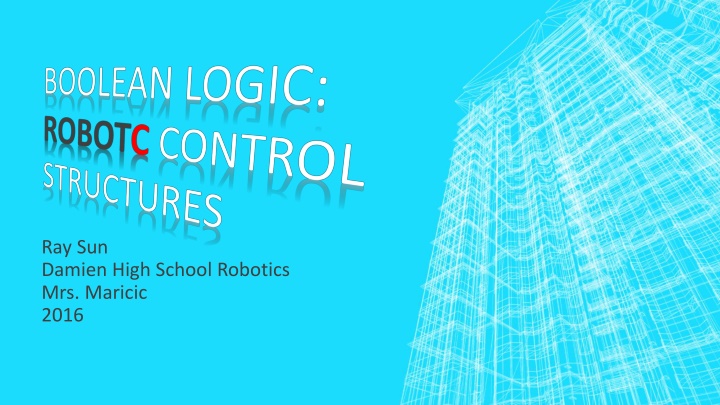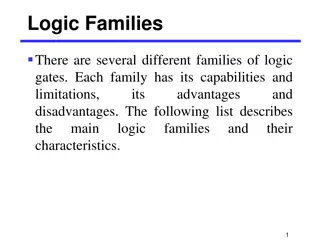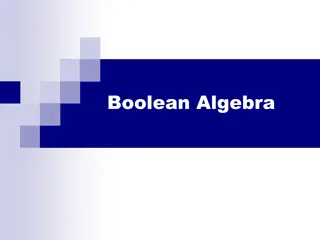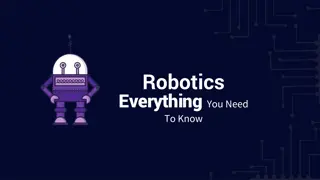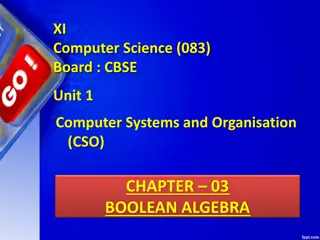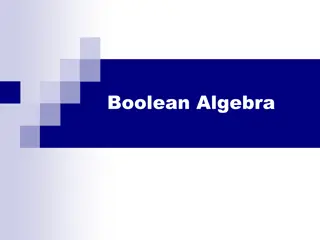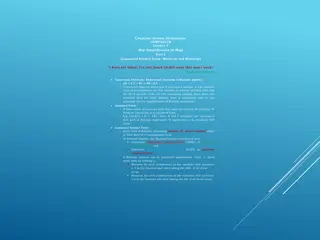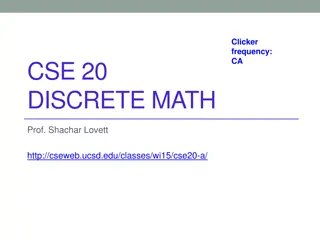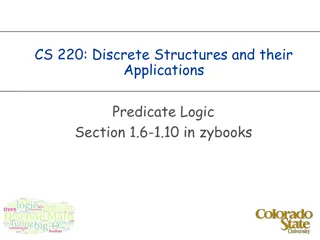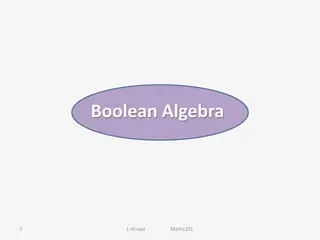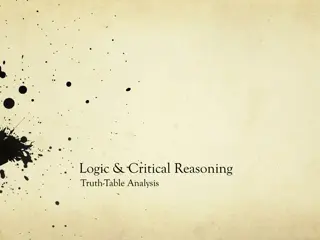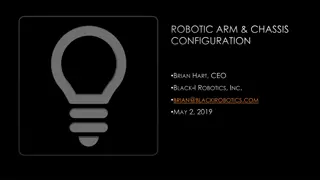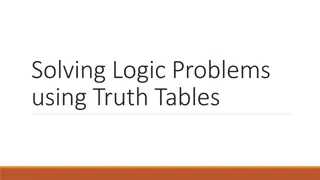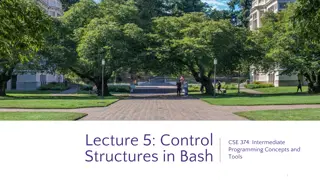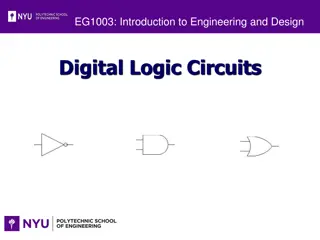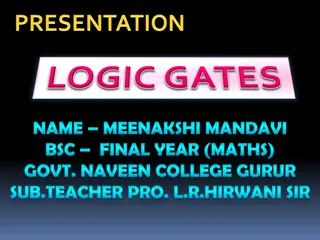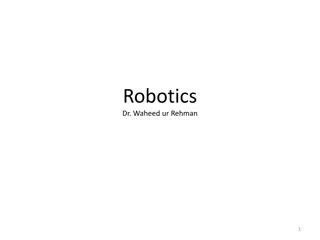Boolean Logic in Robotics: Understanding Truth Values
Boolean logic in robotics involves working with true and false conditions through statements like while and if to control robots based on certain criteria such as sensor readings. This concept, originating from George Boole, is crucial for programming robots to make decisions based on binary outcomes. Learn how to use boolean logic in ROBOTC for effective control structures and conditional statements.
Download Presentation

Please find below an Image/Link to download the presentation.
The content on the website is provided AS IS for your information and personal use only. It may not be sold, licensed, or shared on other websites without obtaining consent from the author.If you encounter any issues during the download, it is possible that the publisher has removed the file from their server.
You are allowed to download the files provided on this website for personal or commercial use, subject to the condition that they are used lawfully. All files are the property of their respective owners.
The content on the website is provided AS IS for your information and personal use only. It may not be sold, licensed, or shared on other websites without obtaining consent from the author.
E N D
Presentation Transcript
Ray Sun Damien High School Robotics Mrs. Maricic 2016
WHAT IS BOOLEAN LOGIC? While it runs, your robot may want to ask some questions to decide what to do: Is the limit switch pressed? Is the current potentiometer reading greater than 2000? These statements have a vital common aspect: they can only be true or false (yes or no). Why is this fact important (for a machine, at least)? Binary, anyone? Such statements are known as Boolean statements, and the true or false condition as truth values.
BOOLEAN? Boolean logic originates from George Boole, an English mathematician and logician who developed a system of working with combinations of true and false conditions known as Boolean algebra. If you are in Digital Electronics (PLTW), this should be familiar The bool type variable (which can only be true or false) in ROBOTC (and most other programming languages) is named after him.
BOOLEAN LOGIC In ROBOTC, true/false questions , such as the previous, must be phrased in statements: while ( condition ) if ( condition ) These are the two most common control structures employed in ROBOTC This is the basis of conditional statements in ROBOTC. They run if the (condition) is true. if ( it is hot in the room ) { (turn on the AC) } What does this do? How do you think a machine would determine if it is hot in the room?
BOOLEAN LOGIC Perhaps the imaginary air conditioning controller could employ a temperature sensor : if ( SensorValue [temperatureSensor] > 72 ) { (turn on the AC) } Please note : Said sensor may be totally imaginary and its depiction extremely untrue to real life. Why is this different, and more suited for a robot, than the previous?
CONDITIONS Most conditions used in control structures are comparisons and equalities : while ( 80 > 79 ) While this might seem trivial, this would actually function properly. if ( 1 == 1 ) When will this run? while ( false ) How about this? true and false are also valid conditions
ROBOTC Language Definition CONDITIONS != == is equal to (NOTE: TWO IS IMPORTANT)* is not equal to > is greater than Other condition operators: >= is greater than or equal to < is less than <= is less than or equal to true (always true) false (always false) * One equals sign ( = ) is used to set the value of a variable to something not to compare!
COMPOUNDS Conditions can be joined by && - and || - or With &&, BOTH conditions need to be true for the overall statement to be true. With ||, only one is necessary. With some creative use of variables, not-and and nor relationships can be constructed. Example: A Boolean variable check is true if A and B are true and false otherwise. Thereafter, if ( ( ( A == true ) || ( B == true ) ) && ( check == false ) )
THE WHILE LOOP A while loop runs repeatedly when its condition is true while ( a == b ) { (Do stuff here) (Go back to condition, check, and repeat if true) } For driver control code : while ( true ) { (Why is the condition truth important here?) } Such a loop that repeats constantly is usually termed a forever or infinite loop Be careful - you can unintentionally cause your robot to become stuck in a infinite while loop, especially in driver controlled operation. If that does happen, you can try utilizing multiple tasks with multiple while loops instead.
THE IF STATEMENT Code in an if-statement is run once if its condition is true. if ( joystick button is pressed ) { motor[Arm] = 127; } if ( true ) Why is this completely redundant? Remember that these conditions are only evaluated when the robot reads that particular line of code.
THE IF STATEMENT There is a problem with the previous button if-statement that renders it useless for actual robot driver control code. What is it? if ( joystick button is pressed ) { motor[Arm] = 127; } What if you wanted the motor to run ONLY if the button is pressed? What happens when you release the button and expect the motor to stop?
THE IF-ELSE STATEMENT If statements can be expanded with a following else statement which would be run if the if-condition is NOT true : if ( joystick button is pressed ) { motor[Arm] = 127; } else { motor[Arm] = 0; } Suppose this block of code were placed within an infinite loop. What happens as that loop repeats and reads this block?
IF - ELSE IF - ELSE IF - ELSE IF ELSE Multiple, different condition checks can be incorporated into a single control structure with else if statements : if ( check first condition ) else if ( if the first condition is false, check second condition ) else if ( if the second condition is false, check third condition ) else ( if all conditions are false, run the code within this else ) Take note that these statements and the code within them should be mutually exclusive they will NOT work at the same time if forced to. If you are using multiple buttons to control multiple motors, as with the previous example, use an if-statement structure for each motor.
THE DO WHILE LOOP This is an alternative to the while loop that fulfills the same function. do { (commands) } while ( condition ) The condition is checked at the end of the loop. Therefore, the code within will always run at least once.
THE FOR LOOP A for loop runs a block of code for a set number of repetitions Always involves a counter variable. Counter is increased ( incremented ) per loop. A for loop is always structured as such : for ( counter declaration, counter condition, increment ) The loop will run as long as the condition is true. Example: for ( int i = 1; i <= 5; i ++ ) Knowing that i ++ means add 1 to variable i , what does this mean? How many times will this loop run?
THE FOR LOOP How many times will this loop run?
SWITCH CASE One of the rarer control structures, a switch case statement utilizes a determinant variable to decide among several sets of code to run. By changing the value of the tested variable, different outcomes may be obtained.
CONCLUDING ADVICE The code snippets originate from http://www.robotc.net/wikiarchive/Control_Structures Resource for control structure layout and know-how If you forget your programming syntax, references include Robotics binder reference (should you have one) ROBOTC Web Help Files (very comprehensive) Above wiki Other robotics members The function library within ROBOTC If your code doesn t work, the error is never the fault of the compiler.
